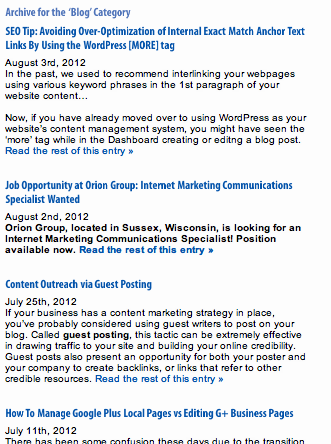In the past, we used to recommend interlinking your webpages using various keyword phrases in the 1st paragraph of your website content…
Now, if you have already moved over to using WordPress as your website’s content management system, you might have seen the ‘more’ tag while in the Dashboard creating or editng a blog post.
 The [more] tag is what usually decides where the “Read More” or “Continue Reading” link is placed in your blog post. This way, your readers could be brought to your main blog category page to see a list of all the lastest blog posts on your site with the titles and a short blurb of text.
The [more] tag is what usually decides where the “Read More” or “Continue Reading” link is placed in your blog post. This way, your readers could be brought to your main blog category page to see a list of all the lastest blog posts on your site with the titles and a short blurb of text.
Well, if you aren’t using the [more] tag, it might be a good idea to try it out. It’s a great way to truncate your content in the category archives and such.
Make sense so far?
Why Should I Use the More Tag

An Example of how content looks on a category archive page in a WordPress blog with the proper use of the [MORE] tag
What we are thinking these days is that it is best to go for more ‘natural’ placement of links from one page to another throughout your site. Our standard practice now is to avoid placing a link to another page before the ‘more’ tag in your blog post entry. This helps to avoid backlinks from being indexed in Google then becoming de-indexed as the blog post moves off of the category page.
Also, beyond that, we recommend not going over board with the number of links and “exact match anchor text“. <~~ click that link to learn more about anchor text in a video by SEOmoz.
So… we get a lot of questions from our clients asking, “How many links should I put in my content?” or, “How many links is too many links in an article?”
Here it is: It is fine to have one link pointing to the home page and perhaps one link to a sub-page on your website. We just wouldn’t recommend over doing it with the ‘exact match’ anchor text these days (post-Google Penguin).
What we are doing for many of our clients now – in an attempt to contribute to a more natural-looking backlink anchor text profile – is adding a word to the beginning and/or end of the desired anchor text of a link to give Google a larger variety of anchor texts with which to work. This helps to avoid over-optimizing a specific exact match anchor text and in turn ensures our clients’ websites are safe from future search engine algorithm updates.
Having said all of that and bringing it back full circle to the [more] tag topic, we recommend:
- Add a [more] tag to your blog posts in WordPress
- Add the [more] tag after the first or second paragraph of your blog post
- Don’t add a link to another page on your website before the [more] tag
- Interlink your content using only a few choice keyword phrases
- Don’t over do it with ‘exact match’ anchor text. Instead, select a longer group of words which with to make your links (example, instead of “Milwaukee roofing company” as the blue clickable link, try making the phrase: “a Milwaukee area roofing company” as the blue clickable link. P.S. Those links don’t work, they are just examples.)

That’s a great quick overview of usage of More tag Scott.
Using More tag helps to avoid copy content issue as well. For example, if you aren’t using a “more” tag on your blog’s main page and two of the paragraphs are visible before the next post on the same main page, then it might happen that those 2 paragraphs will match with “original post URL” and in the “category section” as well = a few % of uniqueness loss in the fresh and originally written post.